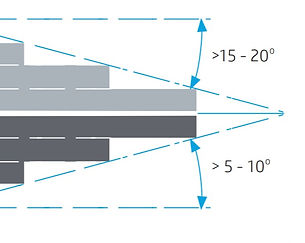How to Design for HP Multi Jet Fusion
With HP's Multi Jet Fusion technology, the printing processes and quality of materials allows for exceptional freedom of design and level of detail, especially compared to traditional manufacturing processes.
As with all 3D printing technologies, there is a set of recommendations to follow when designing for HP Multi Jet Fusion technology to ensure parts and features are printed to specification, as well as to leverage the full potential of the advanced printing processes.
Design Essentials
Tolerances
Expect a dimensional accuracy of +/- 0.3% (with a lower limit of +/- 0.3%)
Bounding Box
This represents the largest model we can manufacture in one piece. As with injection molding, a larger part can be digitally cut and printed in smaller parts, which can be re-connected after printing.
Maximum
284 x 380 x 380 mm
Minimum
x + y + z greater than 9 mm
Wall Thickness
Walls that do not meet the minimum measurements risk damage in the cleaning and printing process. They are also prone to warping during printing.
Min. supported wall thickness
0.4 mm
Min. unsupported wall thickness
0.5 mm
Wires
"Wires" are sections that are long and narrow. Supported wires are connected at 2 ends. Unsupported wires are connected at only one end.
Min. supported wires
0.4 mm
Min. unsupported wires
0.9 mm
Surface Detail
Min. embossed detail
0.2 mm high & wide
for readable text - 0.5 mm wide, 0.3 mm high
Min. debossed detail
0.2 mm high & wide
for readable text - 0.4 mm high & wide
Escape Holes
Because Multi-Jet Fusion uses layers of powder to build parts, excess powder can be trapped in hollow models. The powder can be left in the hollow piece, or "escape holes" can be added so pressurized air can be used to blast out excess powder.
Diameter of single escape hole
4.0 mm
Diameter of 2+ escape holes
2.0 mm
Clearance
Clearance is the space between parts that are built in place, such as in a ball-and-socket joint or hinge.
Minimum clearance
0.6 mm
Sprues
Sprues are wires that join multiple parts. To minimize the risk of breaking during the cleaning process they should be thicker than the minimum wire thickness.
Sprue minimum thickness
2.0 mm


.png)
.png)
_edited.jpg)
